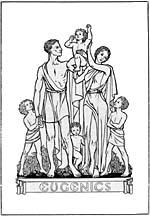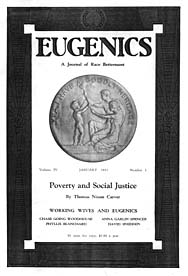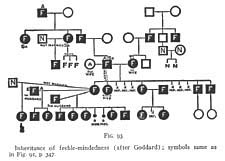


"Society must look upon the germ-plasm as belonging to society and not merely to the individual who carries it." |
||
Study and Report on the Best Practical Means of Cutting Off the Defective Germplasm in the Human Population, 1912 |
||
Q. What is the most precious thing in the world? |
||
American Eugenics Society, A Eugenics Catechism, 1926 |
||
"Eugenics" offered a broad and seductive framework for research and interpretation of the big questions that occupied the attention of scholars and statesmen in the progressive era. The rediscovery of Mendel's laws provided a scientific construct to study and explain perceived social and racial inequities as rooted in heredity, and statistical surveys and newly developed intelligence tests provided the means to measure them. Progressive era interests in scientific approaches to mental hygiene, public health, and child development problems enhanced population anxieties voiced by eugenicists. While biologists promoted race betterment through better breeding, sociologists gave more weight to social forces, as voiced by sociologist Professor Samuel G. Smith at the first International Congress of Eugenics in London in 1912:
"Sir Francis Galton uttered a pregnant sentence when he declared 'the science of heredity is concerned with large populations rather than with individuals....The strength and passion of the social group is measured in no physical terms, but in its ideas, its passions, its ambitions; the social group grows strong by a sense of community of interests. One speech, one race, one tradition imposing themselves victoriously upon every individual produce an impregnable solidarity......Merely biological theories are staggered by the facts of history. It is time to have done with regarding man as simply the highest of the mammals whose breed can be improved by the methods of the stock farm. The problems of race are at once deeper and vaster. As Herbert Spencer's biological interpretation of society has been practically abandoned, notwithstanding his immense services to modern knowledge, so eugenics must follow the path of sociology and give larger room for psychological forces."
 Early
twentieth century eugenics literature promoted the need for research and
the support of societies and agencies to collect, interpret, and disseminate
information on families, ethnic groups and races to be used in professional
training and placed in the hands of public officials
to inform public policy. The Eugenics Record Office at Cold Spring Harbor,
New York, founded by Charles B. Davenport in 1910 and directed by Harry
H. Laughlin, functioned as the clearing house, training center, and research
station for eugenics in the United States. The Human Betterment Foundation
in Pasadena, California, and the New Haven, Connecticut-based American
Eugenics Society advanced eugenics initiatives through state societies
and professional and religious organizations. The National Committee for
the Study of Mental Hygiene, the National Conference of Charities and Corrections,
and U.S. Children's Bureau assisted local efforts to provide data for a
broad scope of social reforms devoted to "human betterment" through reproductive
selection.
Early
twentieth century eugenics literature promoted the need for research and
the support of societies and agencies to collect, interpret, and disseminate
information on families, ethnic groups and races to be used in professional
training and placed in the hands of public officials
to inform public policy. The Eugenics Record Office at Cold Spring Harbor,
New York, founded by Charles B. Davenport in 1910 and directed by Harry
H. Laughlin, functioned as the clearing house, training center, and research
station for eugenics in the United States. The Human Betterment Foundation
in Pasadena, California, and the New Haven, Connecticut-based American
Eugenics Society advanced eugenics initiatives through state societies
and professional and religious organizations. The National Committee for
the Study of Mental Hygiene, the National Conference of Charities and Corrections,
and U.S. Children's Bureau assisted local efforts to provide data for a
broad scope of social reforms devoted to "human betterment" through reproductive
selection.
The ensuing research both responded to and amplified race consciousness and turned procreation into a public issue. Who reproduced, how often, with whom, and with what results in the children, fed fears of national deterioration, troubling trends which could be measured, monitored, and interpreted by the emerging human sciences. Scientific approaches to human problems in the form of surveys provided the tool to monitor human population trends, and the findings of such surveys became the tools to shape public opinion and forge discriminatory social policies. Negative eugenics measures in the United States included forbidding marriage, segregation in institutions, and sexual sterilization of allegedly "unfit parents" and strengthening federal quotas on immigrants (in 1924) from nations believed to be "racially inferior" to Anglo-American stock.
 Eugenics
texts of the 1920s emphasized the convergence of data from the fields of
economics, human genetics, medicine, and the social sciences (sociology,
anthropology, psychology). The power of eugenics ideology, its adaptability,
and its endurance in the face of criticism lay in eugenicists' efforts
to show the interdependence of research data from different fields and
an apparent, if illusionary, consensus on the hereditary nature of social
problems.
Eugenics
texts of the 1920s emphasized the convergence of data from the fields of
economics, human genetics, medicine, and the social sciences (sociology,
anthropology, psychology). The power of eugenics ideology, its adaptability,
and its endurance in the face of criticism lay in eugenicists' efforts
to show the interdependence of research data from different fields and
an apparent, if illusionary, consensus on the hereditary nature of social
problems.
Continue to . . .